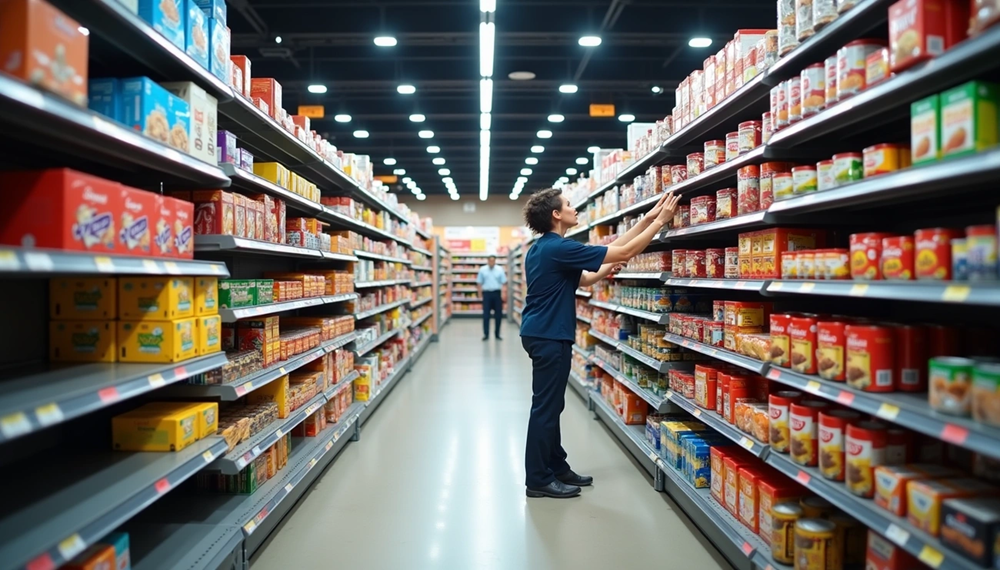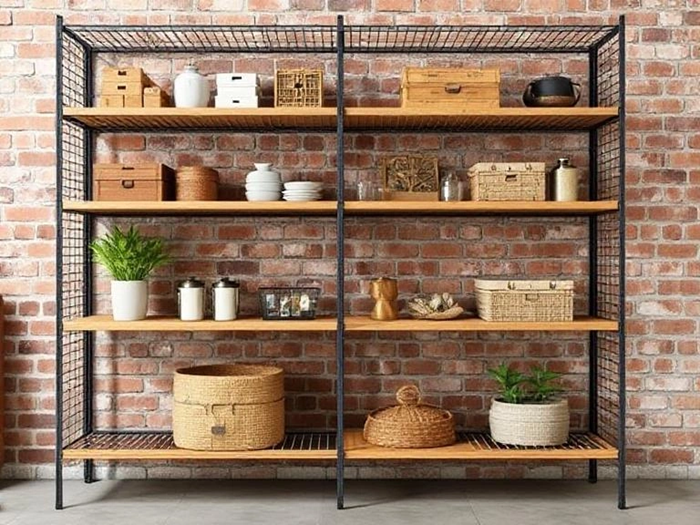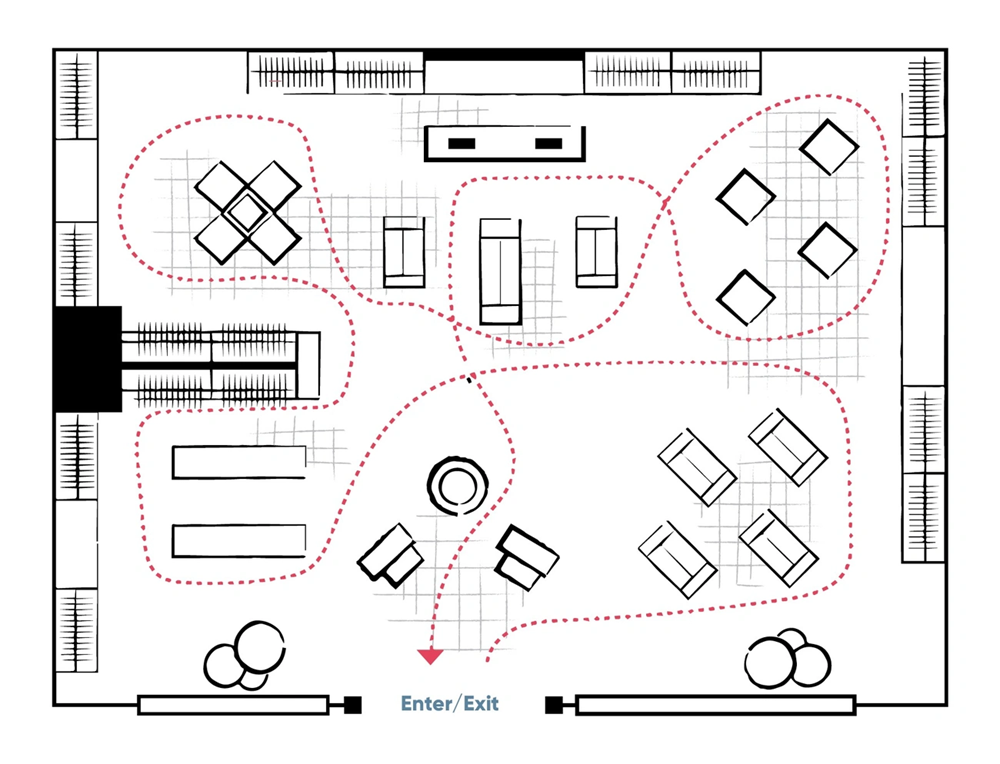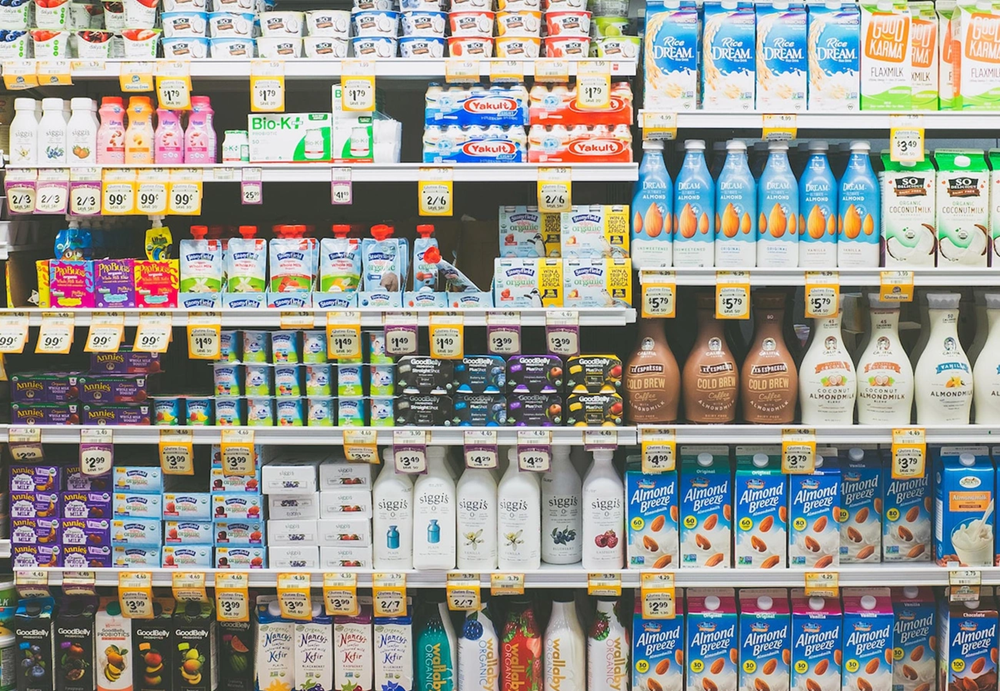
Instagram’s influence on shopping habits is remarkable – 89% of users have purchased products they discovered on the platform. Like social media, retail stores use smart shelf positioning because customers tend to buy what catches their eye.
“Eye-Level = Buy Level” stands as a proven retail strategy that places high-margin and bestselling products where shoppers notice them easily. A successful supermarket shelf system needs smart planning. Stores must keep aisles at least 4 to 5 feet wide between racks so customers can move and reach products easily. The choice of shelf materials makes a difference, too. Powder-coated steel works best for supermarket display racks because it stays strong, resists rust, and lasts longer.
Smart retailers know shelf space optimization goes beyond eye-level placement. They use end caps (shelving at aisle ends) as prime selling spots. Checkout areas work perfectly for impulse purchases such as candy and small snacks. These shelf space marketing techniques create displays that boost sales substantially when retailers execute them properly.
This piece covers everything store owners should know about creating the perfect supermarket shelving system. You’ll learn about materials, types, layout strategies, and how to maintain your shelves properly.
Understand Shelf Types and Materials

Selecting the right shelving system is the foundation for positioning products effectively in your store. Store owners need to make significant decisions about shelf types and materials that will affect product visibility, store operations, and customer experience.
Fixed vs. adjustable shelving
Fixed shelving gives you superior stability through rigid, permanent structures. These systems are great at holding heavier items, and some models can support weights between 200-500 lbs per shelf. The uniform appearance of fixed shelves improves store aesthetics and needs minimal maintenance after you install them.
Adjustable shelving brings versatility that fixed options can’t match. You can move these shelves along vertical supports using pre-drilled holes or tracks. Stores with frequently changing inventory benefit from adjustable shelving because it lets them quickly reconfigure space for different-sized products. Many retailers choose adjustable systems because they can optimize vertical space and adapt to seasonal merchandise changes.
Choosing the right material: metal, wood, or wire
Metal shelving, mostly steel, remains the backbone of most supermarket setups because of its exceptional strength and durability. Steel shelves can handle impressive loads between 200-500 lbs, which makes them perfect for heavy inventory sections.
Wooden shelving adds warmth and visual appeal to specialty areas. Wood shelves support 50-200 lbs per shelf, which works well for premium products, organic sections, or creating a more distinctive shopping environment.
Wire shelving stands out with its open design. These shelves let you see products better and allow air to circulate – this is a big deal as it means that fresh food stays visible and well-ventilated. Wire shelves can handle between 100-300 lbs, and their design lets light pass through to improve product presentation.
Weight capacity and load distribution
Safe and effective shelving depends on understanding load limits. Standard supermarket shelves usually handle between 50-80 kg, while specialized grain and oil shelving can support heavier loads of 100-300 kg. Going over these limits can damage shelves, merchandise, and create safety risks for customers and staff.
Load distribution plays an equally vital role. Even weight distribution across shelves prevents stress points, and placing heavy items near supports helps maintain shelf integrity. Regular shelf stability checks ensure long-term performance and safety.
JY Shop Fitting brings 12+ years of experience in the shop fitting industry to every project. Our core team of commercial shop fitters creates stunning retail spaces that look great and work efficiently.
Plan Your Store Layout and Shelf Space

The success of shelf positioning depends on how well you plan your store’s physical layout. A well-laid-out shopping path will help your products stand out and boost sales.
Measure your retail space accurately
Your first step is to calculate the actual selling space for each shelf and fixture. You need to count linear feet instead of square footage to get precise measurements. A 3-foot wall section gives you 3 linear feet, while a 4-foot-by-2-foot gondola provides 12 linear feet when you add all sides. These detailed measurements help you give more space to your best-performing categories. You should divide shelf space based on each product’s share of total sales with this formula: Optimal Shelf Space = (Product Sales / Total Store Sales) x Total Available Shelf Space.
Think about customer flow and aisle width
The width of your aisles will substantially affect your customers’ comfort and shopping habits. OSHA requires only 28 inches minimum for emergency routes, but grocery stores need 48-60 inches between shelves. This space lets two shopping carts pass side-by-side comfortably. High-traffic areas or sections with bulky items need wider aisles of 72 inches or more. We handle everything from clothing shop fittings to complete shop fittings for retail sectors of all types. Our fitting shop knows each retail project has unique needs. We work closely with you to understand your specific requirements and customer priorities.
Use wall units and gondolas effectively
Gondola shelving forms the core of your store layout with two main setups: wall gondolas that use vertical wall space, and double-sided units that create aisles. Place these fixtures to guide customers through your store in a counterclockwise direction – most shoppers turn right when they enter. This setup increases product exposure and keeps customers browsing longer.
Optimize vertical shelf space
The principle “eye level is buy level” shows why you should put high-margin, popular items at eye level. Products at this height catch your shoppers’ attention and sell better. Your best strategy is vertical merchandising – arrange products in columns instead of rows to match your customers’ natural top-to-bottom scanning patterns.
Optimize Shelf Placement and Product Visibility

Strategic shelf positioning means more than just stacking products on shelves. It creates a visual trip that guides customers’ buying decisions.
Eye-level and kids-level positioning
The “eye level is buy level” principle remains crucial to retail success. Products at eye level get 35% more attention compared to items placed above or below. Retailers should use this premium space to showcase high-margin items or popular products that need maximum visibility. The standard vertical shelf zones include:
- Stretch level (above 1.8m): Lighter items or less popular products
- Eye level (1.2-1.5m): Prime adult-focused placement zone
- Touch level (0.9-1.2m): Children’s eye level—perfect for kid-targeted items
- Stoop level (below 0.9m): Heavier items or lower-margin products
Candy makers place their products at children’s eye level. This strategic placement creates “pester power” that affects parents’ buying decisions.
Use of end caps and focal points
End caps—displays at aisle ends—work as powerful focal points that boost featured product sales by up to 23%. These high-traffic spots naturally catch shoppers’ attention. They work best for new arrivals, seasonal items, or promotions. A 15-degree product slant improves visibility by about 27%.
Group products by category or use
Logical product grouping creates shopping experiences that aid cross-selling opportunities. To name just one example, see how placing chips near salsa or pasta near sauce encourages multiple purchases in one shopping trip.
Apply shelf space marketing techniques
Effective shelf space marketing uses several visibility-enhancing tools:
- Shelf talkers: Small signs that highlight product features or promotions
- Shelf framing: Materials that visually separate and highlight specific products
- Front fencing: Barriers that prevent items from falling while maximizing visibility
- Shelf illumination: Strategic lighting that draws attention to featured products
Most buying decisions happen in-store within eight seconds. These techniques affect impulse buying behavior by a lot.
Evaluate Support, Customization, and Maintenance
Successful shelf positioning goes beyond installation. Your shelves need proper maintenance and support to last longer.
Importance of after-sales service and warranty
Quality after-sales service pays off big time. A small 5% increase in customer retention can boost profits by 25-95%. Getting new customers costs 25 times more than keeping your current ones happy. Good warranties show how much suppliers trust their shelving systems. The best suppliers stand by their products without looking for escape clauses. A complete warranty should protect you against manufacturing defects, weight capacity problems, and structural failures.
Custom shelf sizing and branding options
Customized shelving solutions can turn basic retail spaces into shopping destinations your customers will remember. The acrylic brand displays that you can fully customize to help your merchandise catch attention and boost sales through better product visibility. You can pick custom colors that match your brand’s look. Our shop fittings team turns your ideas and drawings into attractive, working products that lift your store’s atmosphere and boost the customer experience. We are your trusted shopfitting partners who can make a real difference to your retail space. Let’s work together to create a retail space that leaves a lasting mark on your customers.
Regular shelf rotation and cleaning
Clean shelves matter. Dusty displays push customers away and hurt your store’s image. Your cleaning schedule should include daily dusting and weekly deep cleans. Check for loose bolts and anchors twice a year. On top of that, rotating products regularly makes your store feel fresh and active while moving slower inventory. Clean, well-laid-out shelves create a welcoming shopping environment that builds customer trust and brings them back for more.
Conclusion
The right supermarket shelving plays a key role in your store’s success. It shapes how customers experience your store, see products, and make purchases. Store owners should think over shelf types, materials, and weight limits that match their inventory needs. Powder-coated steel stands as the most prominent choice because it lasts long and holds heavy loads. Wood and wire options work well in specific areas too.
Product placement makes all the difference. The “eye level is buy level” rule helps products sell better. Smart aisle spacing and customer flow patterns create an easy-to-use shopping space. Customers stay longer and spend more as a result. End caps, vertical displays, and related product groups also boost cross-selling chances by a lot.
Good maintenance will give your shelving investment lasting value. Clean shelves regularly, rotate products, and check for damage to prevent early wear. You’ll keep the store looking fresh too. Yes, it is true that clean, well-kept shelves build trust and keep customers coming back.
A skilled shop fitting expert can turn basic store layouts into amazing shopping spots. These pros help bring your retail ideas to life with custom solutions for your store’s needs. The ideal supermarket shelving system combines practical use with smart merchandising. This creates retail spaces where products catch attention and customers naturally want to buy.
Key Takeaways
Selecting the right supermarket shelving system requires balancing durability, functionality, and strategic merchandising to maximize sales and customer experience.
• Choose powder-coated steel shelving for durability – supports 200-500 lbs per shelf and offers superior rust resistance for long-term performance.
• Apply “eye level is buy level” positioning – products at eye level (1.2-1.5m) receive 35% more attention and drive higher sales.
• Maintain 48-60 inch aisle widths – allows comfortable two-cart passage and improves customer flow throughout your store.
• Leverage end caps for featured products – aisle-end displays can boost featured product sales by up to 23% due to high visibility.
• Implement regular maintenance schedules – daily dusting and weekly deep cleaning maintain professional appearance and customer confidence.
Strategic shelf placement goes beyond simple product stacking—it creates a visual journey that guides purchasing decisions. When combined with proper materials, optimal spacing, and consistent maintenance, effective shelving systems transform ordinary retail spaces into profitable shopping destinations that encourage customer loyalty and repeat business.
FAQs
Q1. What are the key factors to consider when selecting supermarket shelving? The primary factors include shelf type (fixed or adjustable), material (metal, wood, or wire), weight capacity, and load distribution. Metal shelves offer superior strength, while wood adds warmth, and wire promotes visibility. Understanding weight limits and proper load distribution is crucial for safety and longevity.
Q2. How can store layout and aisle width impact customer experience? Proper aisle width, typically 48-60 inches, allows comfortable two-cart passage and improves customer flow. Strategic use of wall units and gondolas can guide shoppers through the store in a counterclockwise direction, increasing product exposure. Optimizing vertical shelf space by placing popular items at eye level also enhances visibility.
Q3. What are some effective shelf positioning techniques to boost sales? Positioning high-margin products at eye level (1.2-1.5m) can increase attention by 35%. End caps at aisle ends are prime spots for featured items, potentially boosting sales by 23%. Grouping complementary products together, like chips and salsa, facilitates cross-selling opportunities.
Q4. Why is after-sales service and warranty important for shelving systems? Quality after-sales support and comprehensive warranties demonstrate confidence in the shelving system. A good warranty should cover manufacturing defects, weight capacity issues, and structural failures. Proper support can increase customer retention by up to 95%, significantly impacting profitability.
Q5. How can regular maintenance contribute to a positive shopping experience? Consistent cleaning schedules, including daily dusting and weekly deep cleaning, maintain a professional appearance and build customer confidence. Regular product rotation creates an impression of a dynamic store while clearing slow-moving inventory. Organized, clean shelves contribute to a positive shopping atmosphere, encouraging repeat business.

